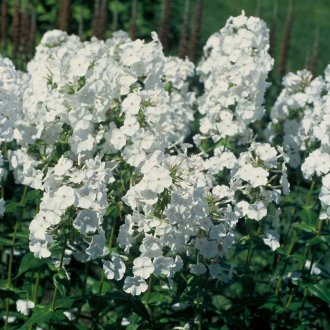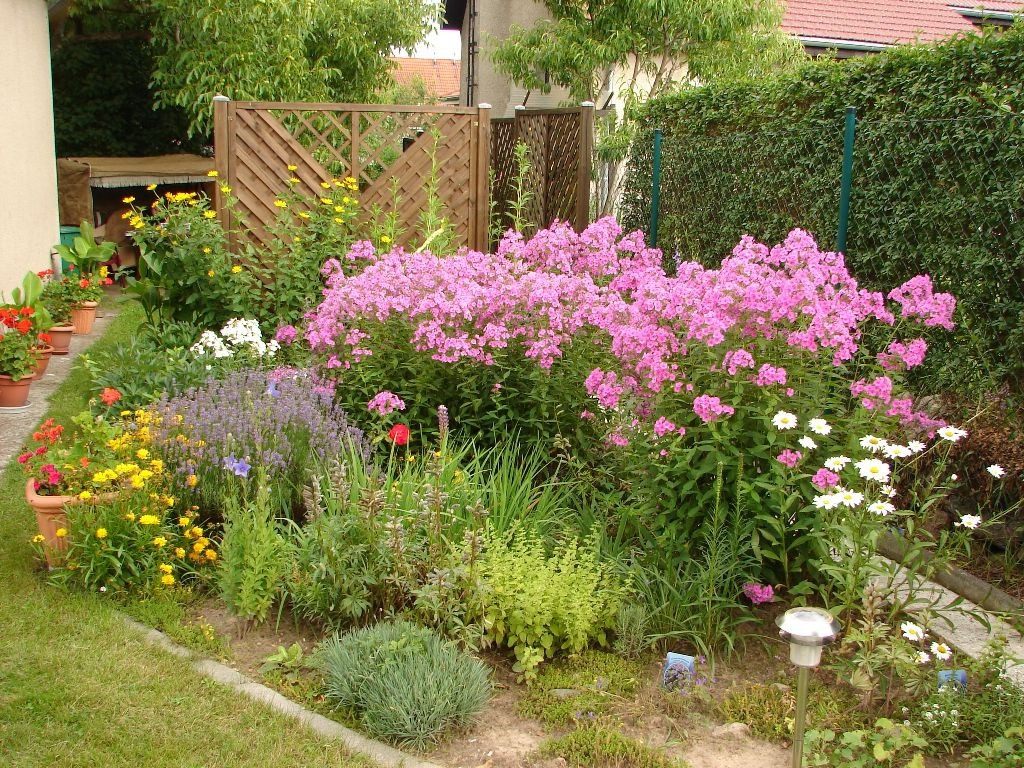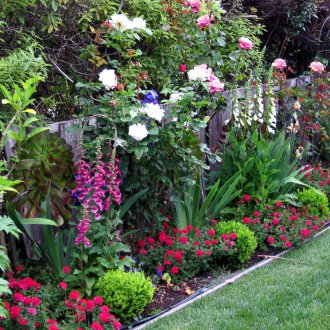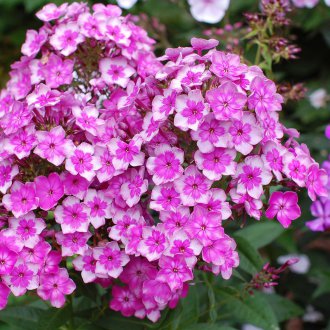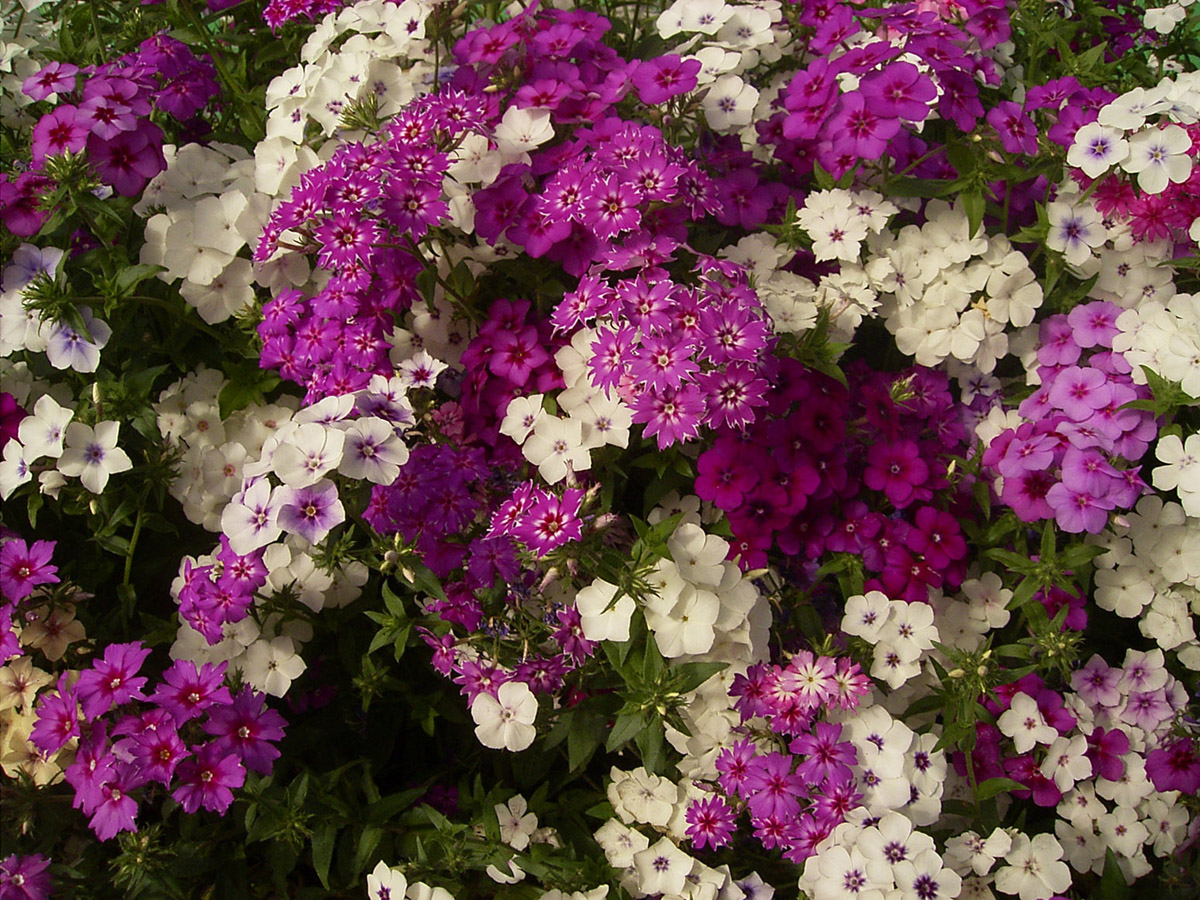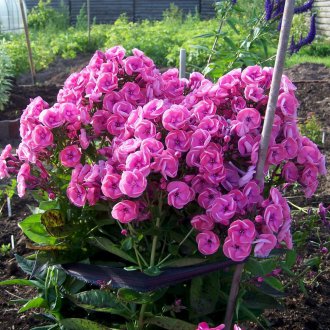Perennial phlox in the garden - beautiful and simple (23 photos)
Content
Phlox flowers are perennial fragrant plants that have become popular due to the beauty of flowering and the simplicity of growing and reproduction. There are many types of phlox, which vary in height and color. On fertile soil, these flowers grow rapidly, forming a colorful decorative layer.
Landing and care
Phlox - unpretentious and hardy perennial plants. Due to their large supply of vitality, planting and care will be within the power of even a novice gardener.
Seat selection
Perennial phlox is preferably grown in open sunny terrain or semi-shady areas. Breeding these plants in dense shade is undesirable, because there they quickly degenerate. Carefully consider choosing a seat near large trees and shrubs. There phlox will have to enter into an unequal battle for the sun's rays, moisture and nutrients. When planting, avoid damp, low-lying areas of the garden. An ideal choice for a flower garden - raised beds.
It is advisable that the landing site of perennial phlox be protected from the wind. If this is not possible, then make a support for the grown bushes (especially tall ones). It is important to consider the color of the plants. So dark phlox should be adjacent to light colored so as not to “get lost” in the dark. Low-growing varieties should be planted in well-lit areas.
The soil
To grow phlox, a loose and fertile soil with a high content of organic elements is needed. It is desirable to plant phloxes in loamy soil mixed with sand. If the soil is too acidic, quicklime should be added to it, which will favorably affect the growth of seedlings. Sandy peaty soil is also suitable for planting.
The addition of natural fertilizers: humus or ash will effectively affect the cultivation of seedlings. To grow healthy phloxes, you need to dig up lots of land well in the fall. And if you are planting seedlings of undersized varieties, you will also have to get rid of the roots of weeds.
Landing time
Growing phlox can be dealt with throughout the vegetative period. Since you can plant seedlings of this plant at any time while it grows and develops, you can choose the time for this process yourself. To plant these perennial bushes, cloudy weather or evening time is required.
In spring, the first half of May is preferable for planting, when the soil has completely thawed after winter frosts. Please note that the flowering period in this case is slightly delayed (approximately 2 weeks). In summer, bushes can only be planted with earth on the rhizome. Be sure to water abundantly and remove the inflorescences so that the flower can take root. The autumn planting period starts in the second half of August and lasts throughout September. In this case, the sooner you plant the plant, the more chances it has to take root and survive the winter.
Watering and feeding
It does not take much time to care for this unpretentious plant. Breeding phlox, you will have to periodically loosen the soil and weed weeds. You will also need to water the bushes and use fertilizers to feed them.
The most time-consuming part of care is watering.Seedlings should be watered under the root 2 times a day: morning and evening. When the flowers are strong, watering can be reduced to 1 time in 2 days. However, if the weather is too hot, the soil will dry out quickly. Then watering should be done daily in the afternoon. With a lack of water, phlox shoots look painful, the leaves dry out and fall off, the buds fade. Regular watering allows you to permanently preserve the beauty of the flowers of this perennial plant.
An important point in the growing process is fertilizer. In order for phloxes to bloom profusely, look healthy, actively grow and survive the winter, it will take 5-6 supplements during the year. Top dressings are:
- Root - the roots are fertilized directly.
- Foliar - leaves are sprayed with diluted organic and mineral substances.
Perennial phlox need care in the fall. They need complex fertilizers, ash or compost in order not to lose their decorative effect. Thanks to well-chosen top dressings, they will delight their hosts with flowering for at least 7 years.
During active flowering, fading inflorescences should be cut. After removing dried flowers, new buds will form in their place. So the flower bed will look attractive for a long time. Pull out dried flowers a couple of times a week. With this simple procedure, you are guaranteed to extend the flowering period until mid-autumn.
Transfer
Phlox should be shared and transplanted. Over the years, the rhizome grows and becomes like a hummock, in which a lot of dying tissue has accumulated. New shoots of the plant appear on the periphery, and the center weakens over time and hardly blooms. A transplant for rejuvenation is carried out every 5-7 years, but it is possible a little more often. The procedure can be transplanted in the spring, summer or autumn.
For spring transplantation (April-May), the soil is prepared in the fall. To do this, dig holes, the distance between which is at least 50 cm for tall varieties and 20-30 cm for undersized species. Pits are filled with compost and fertilizers, and with the help of lime they lower the acidity of the soil. The additives are mixed and watered. Shoots 10-15 cm long are placed in pits for transplantation. In this case, the kidneys for renewal should be covered by 4 cm. After this, a layer of compost is poured, everything is compacted and covered with a layer of mulch of 10 cm.
You can transplant phlox in a flowering state. In this case, the seedling should be carefully dug out so that the root system is not damaged. In summer, abundant watering is required so that the roots do not dry out and take root safely. Pits must be prepared in advance: 2 weeks before transplantation. Plus the division at this time of the year - errors are made when choosing certain varieties.
Phlox can be transplanted in the fall until mid-September. Usually during this period, the upper part of the seedlings is cut off, which contributes to better rooting. If phloxes do not have time to take root before the cold, they will die in the winter.
Breeding
There are several ways to multiply perennial phloxes:
- Seeds;
- Stem, leaf and root cuttings;
- Division;
- Layering.
Seed cultivation is commonly used for creeping species. Dense dark green seeds are harvested in the fall before opening seed boxes and peeled. After that, they are sown in prepared soil, laid out at a distance of 5 cm and sprinkled with a layer of earth. After the snow melts, the seeds begin to germinate. Fortified seedlings can be seated.
A common and effective way is grafting. Shoots from 5 to 15 cm are separated together with part of the rhizome, placed in moist soil and left in the greenhouse. The stalk spends three weeks in a warm, darkened room to take root.
One of the easiest methods of reproduction is division. It is in this way that the popular species, styloid phloxes, is often propagated. To do this, the bush is dug up and divided into parts, which are planted in different holes, carefully immersing the roots in the soil.
The awl-shaped phlox can be propagated by layering. To do this, the stems are bent to the ground. After the plant fades, the stem is fixed and spud with peat. By autumn, the sprouted shoot becomes a full-fledged flower that can be transplanted.
Winter preparations
With the onset of autumn, it is time for gardeners to prepare for the onset of frost. Among perennial phloxes there are many varieties that are not afraid of long winters. The most resistant are considered zoned varieties, but varieties of foreign selection cannot survive without additional warming.
Some gardeners dig up bushes during warm autumn days. Then the plants are packed in buckets, pots or boxes and transferred to the basement, where they will spend time until spring. This process does not justify itself due to excessive complexity and complexity. This option should be used in the case when the seeds did not have time to ripen before the onset of frost.
Phlox can calmly winter in the garden, if they are pre-prepared. It is done like this:
- From mid-October to early November, the ground part of the bushes is cut. Some gardeners leave stumps (10-15 cm high), others cut the flower almost flush with the ground. In the first case, it is possible to protect the kidneys of renewal in this way (they give new shoots), but there is a risk that spores with diseases will overwinter on stumps. In the second option, this is not possible.
- It is necessary to do preventive treatment of the soil and base of the plant. Especially if phlox has been exposed to fungal or viral diseases.
- After 10 days, the planting site of the plant is mulched with peat, garden soil or a layer of manure and humus. Especially carefully cover the cuttings that were planted this year.
Before emergence, the embankment should be removed from the bush, leveling the slides.
Diseases and Pests
Diseases can appear not only in plants that are poorly cared for, but with poor care and the wrong landing site, diseases occur much more often. And without timely treatment, bright and fragrant "residents" of the flowerbed will quickly turn into dried flowers.
The most common disease that phlox overcomes is powdery mildew. This disease begins to affect the stems and leaves of the plant in late July - August. The attractive appearance of phlox quickly deteriorates: the surface of the flower is gradually covered with a white coating. First, the fungus appears on the lower leaves. Then spider webs appear on the stems and upper leaves. Over time, the disease progresses, and the leaves affected by the fungus curl and dry. So a perennial plant weakens and can die.
Treatment of perennial phlox should be started immediately, as soon as you notice the first signs of the disease. Removing the affected leaves only helps partially, soon powdery mildew will appear on neighboring leaves. The main treatment is surface treatment of the plant with a solution of soda and soap (in 10 liters of water dilute 2 teaspoons of soda and 40 g of soap). You can get rid of the disease only with the help of regular (every 7-10 days) sprayings with this solution.
Pests also cause harm to these colorful flowers: wireworm, earwig and nematode. The wire damages the root system of phlox, which is why plants not only undergo various diseases, but also die. Slices of potatoes and carrots will help get rid of this malicious pest. They must be buried in a flower bed to a depth of 10 cm. Once every 5 days, the baits are excavated and destroyed along with the wireworms that climbed inside. Earwigs provoke leaf diseases and spoil buds, they are disposed of with diazinon-based drugs. And you can fight nematodes by planting marigold, marigolds or nasturtium next to phlox.
In order not to spend a lot of time on the treatment of plants, they must be periodically carefully examined.Timely detection of diseases is necessary, pay special attention to newly acquired seedlings. If the shoots are curved, most likely they are susceptible to disease. It is not worth treating young bushes, they need to be destroyed so as not to infect healthy plants.
Phloxes are beautiful and not very demanding plants. Breeders brought a huge variety of varieties of different colors. This variety will make it easy to create a unique landscape composition in your garden.
